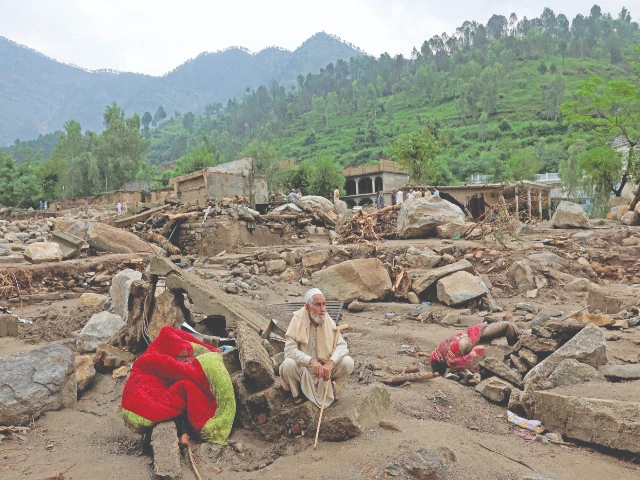Islamabad / Peshawar:
The heavy monsoon rains pushed river levels through Punjab to dangerous peaks, flood the villages, destroy crops and cut access to the ground in several districts, because the National Disaster Management Authority (NDMA) published an emergency alert on Sunday following the forecasts of a new monsoon spell this week.
The NDMA warning came while Khyber-Pakhtunkhwa (KP) won one of the most catastrophic deluge of recent memory that killed more than 300 people. Given the widespread destruction in the province, Prime Minister Shehbaz Sharif precipitated his ministers to oversee the help efforts in the affected districts.
Pakistan is struggling with one of the deadliest seasons in recent memory, because implacable showers, sudden floods and landslides have made at least 657 lives and have made nearly 1,000 injured since the end of June, according to the NDMA.
The National Emergency Operations Center (NEOC) of the NDMA has published an emergency alert providing very strong precipitation through Punjab, KP, Balutchistan, Azad Jammu and Kashmir (AJK) and certain parts of the Sindh.
In a press conference, the president of the NDMA, the LT GEN INAM HAIDER, warned that two to three additional monsoon spells were expected before mid-September, with an intensity of precipitation projected at 50 to 60% of the average levels above average. He attributed the worsening of the situation to climate change.
KP is the most affected. A general devastation was reported to Buner, Bajaur, Swat and Shangla. On Sunday, the number of deaths of Friday cloud explosions, lightning blows and sudden floods increased to 323, including 209 in the Buner district – the epicenter of the disaster.
According to the KP PDMA, the deceased includes 273 men, 29 women and 21 children, while the wounded include 123 men, 23 women and 10 children. The PDMA said that a total of 336 houses have been damaged so far, with 230 partially destroyed and 106 completely demolished.
Since June 26, the NDMA said, rain -related incidents have taken the life of 657 people – 171 children and 94 women – while 929 others have been injured. KP, he added, suffered from the worst, with 390 deaths-288 men, 59 children and 43 women.
In Punjab, 164 lives were lost, the children constituting the largest share of death. The Sindh reported 28 deaths, the Balutchistan 20 deaths, the Gilgit-Baltistan 32, AJK 15 and the territory of the capital of Islamabad 8, according to the NDMA.
Devastation is widespread. “Connectivity with several colonies in Gilgit-Baltistan and KP has been cut due to the sudden floods and landslides. The research operations for the missing people are underway, and more rescue packages will be sent tomorrow,” said the president of the NDMA, Haider.
The Neoc said that the rainy system was active in the Pakistan region and could cause very heavy precipitation at very high hours in the coming 24 hours. Heavy to very strong precipitation with thunderstorms are also planned for Islamabad, with intermittent breaks, he added.
North and superior KP districts, including Swat, Biner, Shangla, Dir, Mansehra, Battagram, Abbottabad and Malakand, should receive strong precipitation over the next 24 hours, with sudden potential floods and landslides in hilly regions, according to the Neoc.
Widespread rains are expected in the districts of Potohar and Northeast, notably Rawalpindi, Attock, Jhelum, Chakwal, Lahore, Gujranwala, Sialkot, Gujrat, Narowal, Hafizabad and Mandi Bahauddin. The central and southern districts – Multan, Rajanpur, Layyah, Bhakkar and Sahiwal – would see dispersed thunderstorms.
Scattered thunderstorms are planned for Peshawar, Charsadda, Nowshera, Mardan and Swabi. South districts, including Dera Ismail Khan, Tank, Bannu, Lakki Marwat, Karak and Kohat, could undergo scattered rains and thunderstorms, with occasional heavy falls.
Likewise, AJK’s districts, notably Muzaffarabad, Rawalakot, Bagh, Haveli, Kotli, Mirpur and Bhimber, and Gilgit, Skardu, Hunza, Ghizer, Diamer, Astore, Ghanche, and Shigar Gilgit-Baltistan districts, especially to receive significant precipitation. of earth and lots of jumps, in mountains in the mountains.
The coastal districts of the Sindh – Karachi, Thitta, Sujawal, Badin and Tharparkar – can see intermittent showers or thunderstorms. Central and Upper Sindh – Hyderabad, Nawabshah, Dadu, Khairpur, Sukkur, Ghotki, Larkana, Shikarpur, Jacobabad and Kashmore – are likely to receive moderate to strong precipitation.
In Balutchistan, districts such as Lasbela, Khuzdar, Awaran, Kalat, Gwadar, Turbat and Panjgur should receive dispersed precipitation, while northern and central districts, especially Quetta, Ziarat, Zhob, Loralai, Barkhan, Musa Khel, Dera Bugti and Kohlu, can see light.
The NDMA has urged citizens to avoid non -essential trips and to remain vigilant of changing weather conditions. “People are invited to park vehicles in safe areas, far from trees, panels and weak structures, and to avoid movements near rivers, streams and areas subject to landslide,” said the alert.
“The crossing of submerged roads, bridges or fast flowing water canals is strongly discouraged. Institutions must take precautionary measures, ensure that machines and pumps are ready to drain in low zones and quickly react to all emerging threats.”
Rescue efforts
Meanwhile, emergency efforts in the affected areas of KP have continued. On the instructions of Prime Minister Shehbaz Sharif, additional goods were sent to the areas affected by the floods. On its directives, federal ministers will participate in rescue operations.
The Prime Minister’s office said in a document that cashmere and the Minister of Affairs GB Amir Muqam would supervise the distribution of rescue goods in the districts of Shangla and Buner with the help of the Minister of Power.
The Minister of Religious Affairs, Sardar Yousaf, will supervise operations in Manshra, while the special assistant of Prime Minister Mubarak Zeb will supervise the distribution of aid to Bajaur, according to the document.
The Prime Minister personally supervises NDMA’s rescue operations in all districts affected by KP floods. “We stick to the victims of the floods during this time of difficulty,” said Prime Minister who quoted the Prime Minister.
The KP PDMA said on Sunday that it had sent 89 trucks of emergency products, including more than 2,800 tents, 3,800 covers, 1,750 solar lamps and 800 million financial assistance rupees in affected areas.
The chief minister of KP, Ali Amin Gandapur, visited Swat. He assured the victims of the floods that the government rebuilt their destroyed houses and would move families from the rivers of rivers to newly developed colonies.
Meanwhile, the Punjab PDMA said that the province was currently living in the seventh rains from Mousson, which would continue until August 23.
In the past 24 hours, strong precipitation has been recorded in several parts of Punjab. Islamabad received up to 76 millimeters in Golra and 75 millimeters in Saidpur, while Rawalpindi recorded 53 millimeters in Chaklala. Jhelum, Siackot, Mangla and Mandi Bahauddin also reported significant precipitation.
Due to the rain, the Sutlej river has increased sharply in the Kasur district, overwhelming dozens of villages and large expanses of agricultural land. PDMA officials reported a water discharge at the Ganda Singh Wala Headworks reached 75,000 brackets.
The thrust destroyed standing crops, damaged hundreds of agricultural land acres and moved dozens of families. Authorities have warned that additional Harike Headworks water versions could intensify the floods, putting the downstream communities more in danger.
In Bahawalnagar, the violations of protective embankments allowed flood waters to spread in the villages, which prompted the administration of the district to impose article 144 to restrict civil movements along the banks.
In the Zafarwal Tehsil of Narowal, the DEK Nullah swelled with more than 22,000 water records, flooding villages nearby and damaging the houses. The rescue teams have deployed boats to move blocked residents, while the flood emergency camps have provided necessary aid, officials said.
The Federal Flood Commission (FFC) indicated that the Industry River was in average flood in Kalabagh, Chashma and Taunsa, while the Tarbela dam is 98%. The mangla dam is 1,211 feet, just 30 feet under its maximum storage level.
The chief minister of Punjab, Maryam Nawaz Sharif, ordered all administrations and rescue agencies to stay on alert, especially in the Murrier valleys, Rawalpindi, Jhelum and Koh-E-Sulaiman. A ban was imposed on tourist trips to Murrier in the midst of the fears of clouds and landslides.




